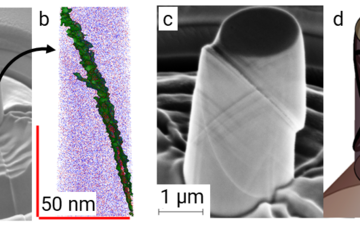All genres
1341.
Talk
Temperature dependent properites of Shape-memory alloys. Physics Seminar of Loughborough University, Loughborough, UK (2006)
1342.
Talk
Electronic properties of non-stoichiometric dislocation cores in GaN. Materials Research Society fall meeting, Boston, MA, USA (2005)
1343.
Talk
The Bandgaps of GaN and InN in Zinc-blende and Wurtzite Phase: DFT Calculations Using the Exact Exchange (EXX) Functional. Workshop Forschergruppe Bremen, Bad Bederkesa, Germany (2005)
1344.
Talk
Determination of Thermodynamic Quantities from Ab Initio Methods. WTL Learnshop, Aachen, Germany (2005)
1345.
Talk
Temperature-dependent ab initio investigation of the martensitic phase transition in magnetic SMAs. Kickoff-Workshop of SPP1239, Dresden, Germany (2005)
1346.
Talk
Ab initio Thermodynamics: Concepts and Application on Bulk Properties and Epitaxial Growth. UCSB-Workshop, Berlin, Germany (2005)
1347.
Talk
Multiscale Simulation of Crystal Growth Processes. IWCGT-3 Workshop, Beatenberg, Switzerland (2005)
1348.
Talk
Ab initio based multiscale modeling of dislocations in GaN. E-MRS-Fall Meeting, Warsaw, Poland (2005)
1349.
Talk
Surface Physics of Group III-Nitride Semicondutors. ECCOSS 23, Berlin, Germany (2005)
1350.
Talk
The role of strain fields, core structure, and native defects on the electrical activity of dislocations in GaN. The 6th International Conference on Nitride Semiconductors, Bremen (2005)
1351.
Talk
Ab initio Multiskalensimulationen zum Wachstum und zur Defektstruktur von Gruppe-III-Nitriden. Kolloquium, Universität Bochum (2005)
1352.
Talk
Ab initio Simulations of Solid State Processes. Geomat-Konferenz, Aachen, Germany (2005)
1353.
Talk
A DFT-GGA based thermodynamic analysis of the secondary structure of proteins. DPG-Jahrestagung, Berlin, Germany (2005)
1354.
Talk
Generalized Wannier functions: An accurate and efficient way to construct ab-initio tight-binding orbitals. DPG-Tagung, Berlin, Germany (2005)
1355.
Talk
Formation of steps and vicinal surfaces on GaN (0001) surfaces: Implications on surface morphologies and surface roughening. DPG spring meeting, Berlin, Germany (2005)
1356.
Talk
Computergestütztes Materialdesign mittels ab initio Multiskalenmethoden. Kolloquium IWF, Dresden, Germany (2005)
1357.
Talk
Ab initio Multiskalensimulationen zu Defekten und zum Wachstum von breitlückigen Halbleitern. SiC-Kolloquium, Universität Erlangen-Nürnberg (2005)
1358.
Conference Report
Role of Simulations and Experiments in Analytical Field Ion Microscopy. Microscopy and Microanalysis 29 (Supplement_1), p. 602 (2023)
1359.
Poster
Analysis of the reactive solid-liquid interface during the corrosion of magnesium at the near atomic level using cryo-atom probe tomography. Aqueous Corrosion Gordon Research Conference (GRC) 2024, Corrosion Challenges and Opportunities for the Energy Transition, New London, CT, USA (2024)
1360.
Poster
Analysis of the reactive solid-liquid interface during the corrosion of magnesium at the near atomic level using cryo-atom probe tomography. Aqueous Corrosion Gordon Research Seminar (GRS) 2024, Corrosion Monitoring, Modelling and Mitigation Towards a Sustainable Future, New London, CT, USA (2024)











